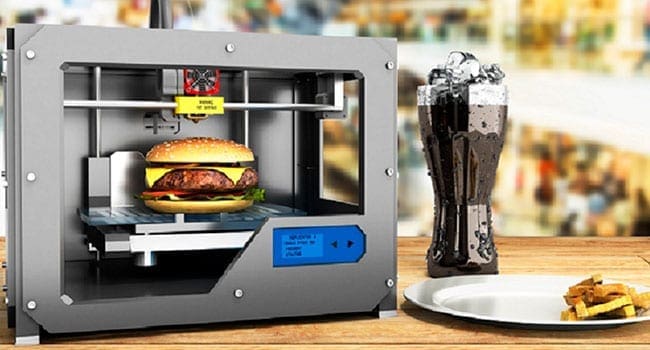 A few weeks ago, Londoners were able to eat at the world’s first 3D printed, pop-up restaurant. In early June, a German-based company introduced the word’s first plug-and-play food printer, which may be ready for shipping as early as 2016. With the lowering cost to produce this technology, making it increasingly accessible, 3D printing could fundamentally change our relationship with food.
A few weeks ago, Londoners were able to eat at the world’s first 3D printed, pop-up restaurant. In early June, a German-based company introduced the word’s first plug-and-play food printer, which may be ready for shipping as early as 2016. With the lowering cost to produce this technology, making it increasingly accessible, 3D printing could fundamentally change our relationship with food.
Simply put, the process uses ingredients to generate three dimensional meals by placing layers of compounded food on top of each other. Since 2012, the food industry has used this technology to produce ubiquitous food products like candy, chocolate, pizza, noodles and even crackers. Despite its relative novelty, many companies are recognizing its potential and how 3D food printing can revolutionize global food systems.
In particular, 3D printing could radically alter food production practices by enabling companies to manage resources more responsibly, and reduce waste across the food continuum whether you are a food processor, distributor or a consumer with leftovers. Indeed, many well-known agribusiness corporations have already dedicated a great deal of time and research on 3D systems. There is a potential benefit to consumer health as well. For example, PepsiCo recently announced that it is using 3D printing technology to develop a healthier potato chip, one of the most popular snack foods of all time.
Beyond manufacturing, 3D printing could also boost culinary creativity by allowing renowned Chefs to create shapes and forms previously thought impossible. Some have also argued that it can also give the food service industry the ability to customize products based on individual nutritional needs.
Given our demographic challenges over the next few decades, this can become a key benefit. For example, many nursing homes in Germany already produce a 3D-printed food product called smoothfoods for residents who have difficulty ingesting food, or even chewing them. While regular smoothies have been on the menu, but haven’t proved popular, residents eating smoothfoods can receive all the nutrients they require, while enjoying an aesthetically pleasing meal. As a result, the elderly can live healthier, higher quality lives.
More significantly, some experts believe 3D printing could effectively address global food security challenges: ingredients such as algae, duckweed, and grass could be imbedded into familiar dishes. A recent study in Holland added milled mealworm to a shortbread cookie recipe though 3D printing. Most would agree that a cookie-shaped food product is much more appetizing than the look and feel of a worm. By using insects and other protein sources, the growing need for protein the globe is currently experiencing, which adds increased pressure to beef and pork prices, could be mitigated.
Currently, 3D food printing still faces major obstacles. The technology remains expensive and complex. The engineering required to produce food is much more sophisticated than producing objects with metal and plastic. Food scientists also admit how difficult it is to effectively make edible meals in 3D food printing because ingredients in food interact in many complex ways, particularly with meats. At this point, taste wise, 3D food printers are not known to produce great tasting food, and still do not have the overwhelming endorsement of the culinary world. However, the technology is improving at an incredible pace, allowing us to believe that, very soon, anything in the realm of food might be possible.
The concept of 3D printed food is foreign to many of us, and may challenge our collective appreciation of where food comes from, and how it is produced. Let’s face it, when it comes to food we are all traditionalists to some extent, and we are protective of our food heritage. Printing food is a drastic departure from the art of cooking as a way of celebrating nature’s bounty.
The reality is, however, that we will have over nine billion people to feed in just a few years. One of the ways to responsibly address global food security challenges is to consider technology as a primary source for sustainable solutions, and to continue to consider alternatives to established food production systems as mere fads may not be the best approach. The future of the dinner table may be as different, and as simple, as press print and eat.
Dr. Sylvain Charlebois is senior director of the agri-food analytics lab and a professor in food distribution and policy at Dalhousie University.
Sylvain is a Troy Media contributor. Why aren’t you?
The views, opinions and positions expressed by columnists and contributors are the author’s alone. They do not inherently or expressly reflect the views, opinions and/or positions of our publication.


